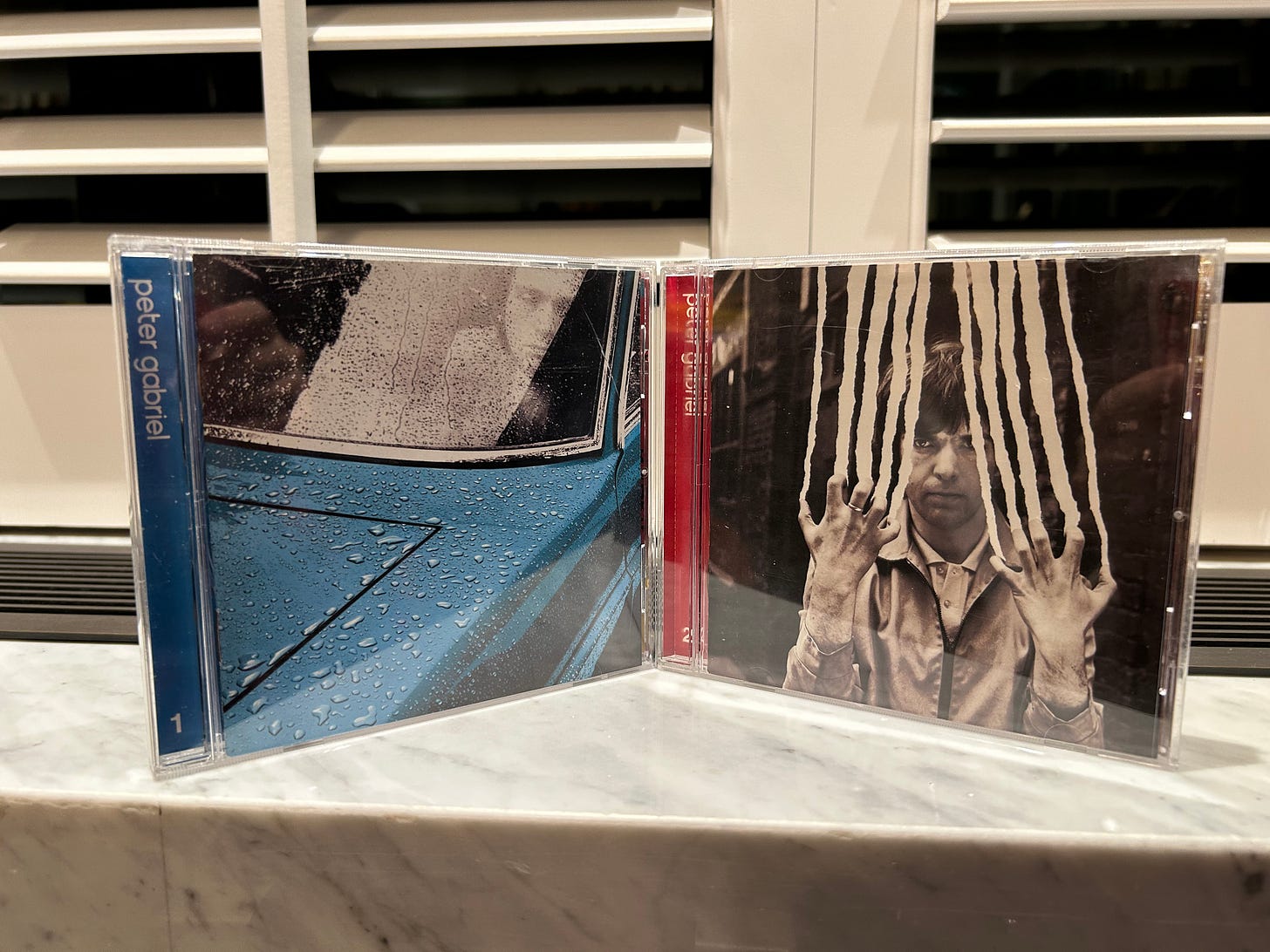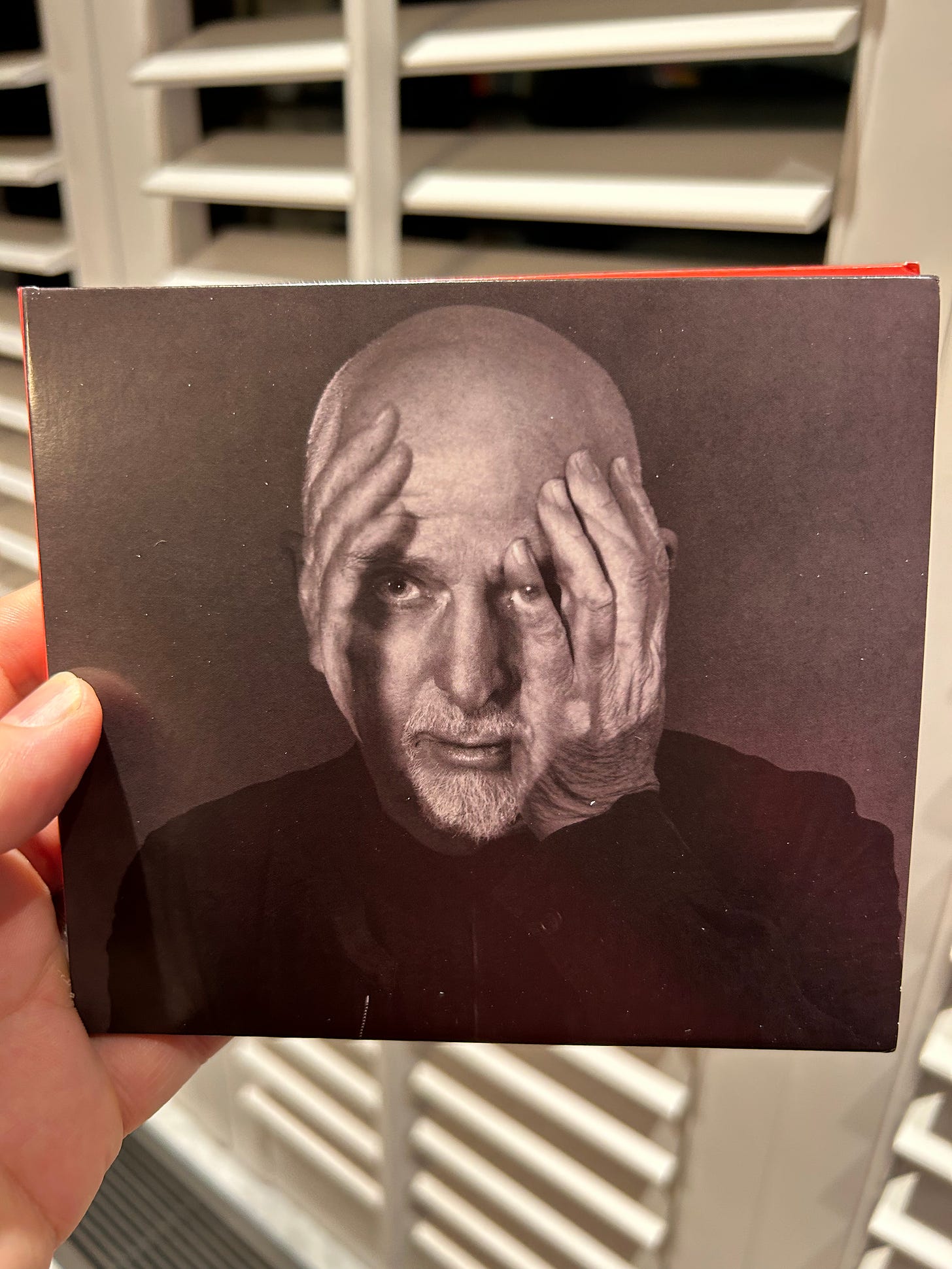The 25 best Peter Gabriel songs, according to me (Part 1)
A full-career appreciation to honor the release of his first album of original songs in 21 years
I’ve thought long and hard about this, but I always arrive at the same conclusion: Peter Gabriel is my favorite living singer. How to describe the marvel that his vocal cords create? Most critics’ attempts tend to lean on adjectives like “husky,” “scratchy” and “weathered.” All of which are apt but none of which do his voice sufficient justice. Tucked within those rough grains you can find about a thousand layers of drama, representing the whole spectrum of human emotion: heart-busting tenderness, goofy sarcasm, caustic rage, profound soul (he’s clearly spent many hours drinking from the Ray Charles well). And the manifold ways in which he uses that voice are guaranteed to bore a hole straight into my chest cavity on a regular basis—figuratively speaking, of course. The agonized yelps, the high wails, the feral cries, the aching long notes that seem to dial the rasp level in and out on command … every one of these trademark mannerisms feels completely right to me.
It’s been this way ever since I first encountered Gabriel’s music when I was 10 years old. Why? I can’t really explain it, but I’ve long felt a sort of vocal kinship with him. I spent a lot of time in my teen years listening to classic-rock singers—Roger Daltrey, Steve Winwood, Robert Plant, Ian Gillan, Jon Anderson—but I also wanted to sing myself, and when I tried to sing like those guys, the results were embarrassing. Peter Gabriel’s vocal style was one of the first I came across that I both liked and thought I might be able to imitate. I spent countless hours listening to his solo albums and his earlier work with Genesis, trying to master the way he would switch from full voice to falsetto, practicing how he’d lean in on certain notes and hold back on others. Young artists need role models like this, guides to help them progress in both technique and spirit. Few musicians have had as foundational an influence on me as Peter Gabriel. Not only was I deeply inspired by him, not only did I learn an enormous amount from him, but he helped point me toward my own voice.
Today Gabriel, now 73, officially released i/o, his first album of original songs since 2002. Miracle of miracles, his singing on it remains as affecting as ever. And you can’t put that down to studio trickery; I saw him perform live at Madison Square Garden in September and could hardly believe how great he sounded. (I expect that spending most of the past two decades not making records and touring the world repeatedly has helped his vocal health.)
In anticipation of the new album’s release, my writer friend Morgan Enos was trying to compile a top-10 all-time list of Gabriel songs for Grammy.com. He consulted with me on it, and I must admit I wasn’t entirely helpful. I gave him a list 25 tracks long, which didn’t include most of the songs generally associated with PG: no “Solsbury Hill,” no “Games Without Frontiers,” no “Sledgehammer,” no “Big Time,” no “In Your Eyes.” Not that I don’t love all those songs—I do—but they get enough attention as it is. More to the point, I don’t believe they showcase Gabriel the singer to best effect. Of course, you can’t claim to be truly representative of his overall career if you bypass the numbers mentioned above. But luckily, the need to be complete in that way is no concern of mine. And so, after putting all 25 cuts into a private TIDAL playlist, giving it a test listen and approving heartily, I decided to publish my own list, with commentary. To avoid an endless scroll experience, I’m dividing the list into five groups of five. Instead of being presumptuous and ranking them, I’ve chosen to put them in roughly chronological order. But because I can’t resist, I’ll tell you which one will always be my number-one when we get there.
“Here Comes the Flood” (Robert Fripp: Exposure, 1979)
Gabriel has recorded several versions of this early masterpiece. The first version to be released, and the easiest one to find, is the grand finale of his self-titled debut solo album from 1977 (the first of four consecutive self-titled albums). That rendition, produced by Bob Ezrin, has its virtues but is a tad bombastic for my taste. The definitive take, I’d argue, is on Robert Fripp’s Exposure, also his first solo album, which features contributions from several artists with whom Fripp worked closely in the late ’70s, including Gabriel. It’s the definitive take because it’s simple; the only players are Gabriel (vocal and piano), Brian Eno (a few subtle synthesizer notes), and Fripp (looped electric guitar, a.k.a. “Frippertronics,” taking the role of fuzzed-out string section). Fewer instruments mean more room for the voice to inhabit, and a performance as beautifully haunted as this requires plenty of room. Remember what I said earlier about long notes that dial the rasp in and out? Exhibit A: the opening word of this song’s chorus, “Lord,” in all its wounded-animal desperation.
“Humdrum” (Peter Gabriel 1 [Car], 1977)
Three distinct vocal personalities coexist in this song. The first—you hear it at the beginning, accompanied only by Fender Rhodes electric piano—is quiet, hesitant, barely able to get the words out. The second—backed by what sound like accordion and castanets in a brief tango collision—is more urgent and declamatory. The third—which enters just when the music seems to have expanded into multiple new dimensions, and which dominates the song’s majestic outro—is almost impossibly low and gravelly. The dial is now set to full rasp, and you’d be forgiven if you thought it was a different person singing. This chameleonic turn and others like it on the Car album (“Moribund the Burgermeister,” for example) connect to Gabriel’s explicitly theatrical stylings with Genesis between 1971 and 1975; that he also steps out on flute here during an instrumental interlude is a further link to earlier days.

“On the Air” (Peter Gabriel 2 [Scratch], 1978)
You don’t hear the Gabriel snarl much anymore, but it used to be one of his most compelling moves (check out “Back in N.Y.C.” from Genesis’ The Lamb Lies Down on Broadway for extra proof). And it’s all over this hard-rocking opener to his second solo album. For decades I loved this song while barely having any idea what the words were; now that I know them, I’ve come to realize that I didn’t miss much. “On the Air” is apparently sung by a character called Mozo, a social outcast/ham radio operator who was the antihero of an unrealized Gabriel concept piece. Whatever. The only actual lyric one need remember here is “I’m proud to be loud,” which Gabriel delivers with an extremely appropriate bellow. Also worthy of note is Tony Levin’s ridiculously muscular bass playing. (Any collection of Gabriel highlights is also a collection of Levin highlights, as they’ve been a team for more than 45 years now.)
“Indigo” (Peter Gabriel 2 [Scratch], 1978)
A gorgeous ballad with unusual instrumentation—featuring a gang of recorders, twangy steel guitar and the rather morbid overtones of a bowed acoustic bass (again courtesy of Mr. Levin)—this is an early example of Gabriel daring not to take refuge behind a character in song. The lyrics are, or at least seem to be, more personal, and he sings them with transparent emotion: sad acceptance in the lower octave, growing panic in the upper one. A line toward the track’s end, “See you again someday,” is archetypal PG. “Day” becomes a two-syllable word, the first spat out under duress, the second a much higher-pitched cry for help, almost stifled but not quite.
“And Through the Wire” (Peter Gabriel 3 [Melt], 1980)
More snarl and rasp, with raucous guitar chords from the Jam’s Paul Weller providing perfect accompaniment. The malevolent way Gabriel stretches out the word “wire” in the choruses is brilliant enough, but two spots in the bridge are even better. First, “staring at the shape of things”—total sneer, with “things” getting treated to a sardonic loop-de-loop action that never fails to make me marvel. Second, for one line only—“Overloaded with everything we say”—Gabriel pulls out the same low, gravelly voice we heard at the end of “Humdrum.” Holy split personality, Wireman! Virtuoso moment.
Next up: Part 2, featuring five remarkable PG recordings from the early ’80s.





Mac, great start here. I think you know I share your devotion to Gabriel. Seeing the MSG show with you was great. I, too, was amazed. Waiting impatiently for the next installments. Sincerely, your favorite drummer.